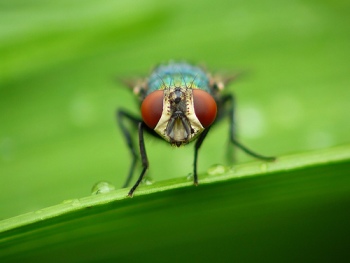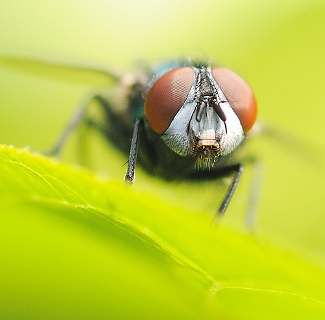Classification
Domain: Eukarya
Kingdom: Animalia (Animals)

Phylum: Arthropoda (Arthropods)
Class: Hexapoda (Insects)
Order: Diptera (Flies)
Family: Calliphoridae (Blow Flies)
Genus: Lucilia
Species: sericata (Common Green Bottle Fly)
Why organisms are classified at each level
Eukarya: All organisms are eukaryotes that posses a true nucleus
and membrane bound organelles.
Animalia: Organisms are mulitcellular with no cell walls and are
heterotrophic.
Arthropoda: Organisms are invertebrates, bilaterally
symmetrical, contain chitin, and have segmented bodies.
Hexapoda: Organisms contain a head, thorax, and abdomen. Other
features include compound eyes, three pairs of legs, and
optional wings.
Diptera: Organisms are holometabolous and have only one pair of
wings in the adult stage. The wings are attached to the
mesothorax.
Calliphoridae: Blue, green, or bronze metallic-looking flies
that measure about 4-16mm. Larvae are pale yellow to white.
Lucilia: Develop on carrion or feces, and are able of
affect living hosts.
sericata: They have a blue-green metallic color with
clear brown veined wings. This organism is commonly used for
maggot therapy.

How do the different subphylum of Arthropoda relate to one another?
All arthropods include the subphylums Hexapoda, Crustacea, Myriapoda, and
Chelicerata. Lucilia sericata falls into the Hexapoda
class. There has been debate on how these organisms relate to
one another within the arthropoda phylum. The figures below
compare two phylogenetic trees based on morphological and
molecular characteristics. The study was done by Clifford W.
Cunningham at the University of Maryland. Figure one shows the
relationships by using nuclear protein-coding sequences. This
shows that the Myripoda would be closely related to the
Crustacea and Hexapoda. Figure two shows the relationships by
using morphological characteristics. This shows that Myripoda
would be more closely related to the Chelicerata.
Figure One.
Figure Two.
Both Figures were created by Jennifer Stutz.
Now let's take a look at the
Habitat
of Lucilia sericata!